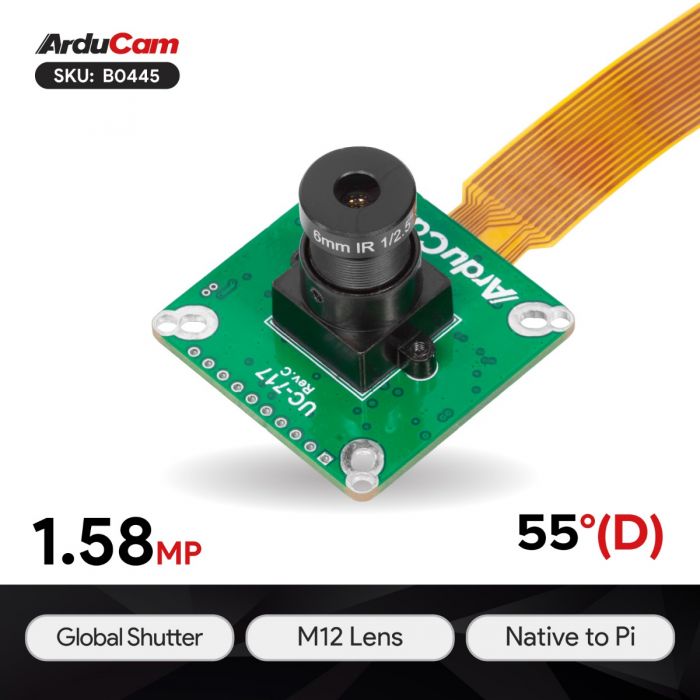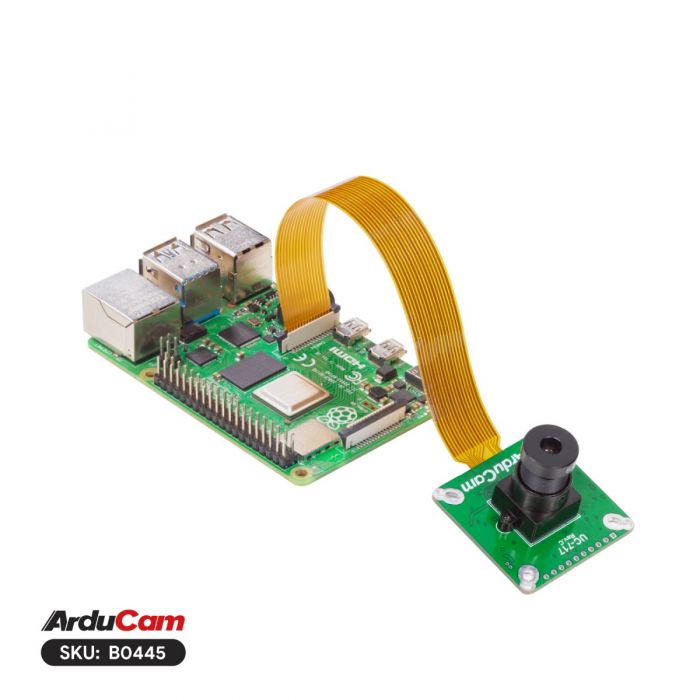1.58MP IMX296
Introduction
The Sony IMX296 is a global shutter CMOS image sensor with a resolution of 1.6 megapixels and a pixel size of 3.4µm x 3.4µm. A global shutter sensor captures an entire image at once, unlike a rolling shutter sensor that scans an image line by line. This means that global shutter sensors can avoid distortion and motion blur when capturing fast-moving objects.
The Sony IMX296 sensor is suitable for various industrial and machine vision applications, such as robotics, inspection, surveillance, and high-speed imaging. It can also be used with different types of lenses, such as C/CS-mount lenses, and can be integrated with Arducam camera module for embedded system/platforms using.
Common Specs
| Image Sensor | IMX296 |
|---|---|
| Resolution | 1.58MP |
| Optical Size | 1/2.9(6.3mm sensor diagonal) |
| Number of effective pixels | 1440(H) × 1080(V) |
| Pixel Size | 3.4μm × 3.4μm |
| Interface | MIPI CSI-2 Interface |
| Shutter Type | Global Shutter |
| Color Filter Array | Quad-Bayer RGB |
| Frame Rate | 1440x1080@60fps |
| Output Format | RAW10 |
Product
| Product Image | SKU | Resolution | Sensor | Interface | Features | Focus Type | Focal Length | Field of View(DxHxV) | IR Sensitivity |
|---|---|---|---|---|---|---|---|---|---|
 |
B0445 | 1.58MP | IMX296 | MIPI CSI-2 | Color Global Shutter | Manual focus | 6mm | 55°(D)x45°(H)x33°(V) | Integral IR-cut Filter |
Quick Start
Hardware
Hardware Connection for Raspberry Pi 4B / Pi Zero
 |
 |
Software
Note
Please make sure you are running the latest version of Raspberry Pi OS. (January 28th,2022 or later releases, Debian version:11(Bullseye) or Bookworm OS). You need to update the config file and use libcamera apps.
Supported Platforms and OS
| Note for Supported Platform and OS | |||
|---|---|---|---|
| Platform | Bookworm(rpicam/libcamera) | Bullseye(libcamera) | Buster(raspistill) |
| Raspberry Pi 5 | √ | ||
| Raspberry Pi 4B / 3B+ / 3A+ / Zero / Zero 2 W | √ | √ | √ |
| Raspberry Pi CM3 / CM3+ / CM4 (extra adapter board required) |
√ | √ | √ |
Software Configuration
-
Bookworm OS & Pi 5
For Raspberry Pi Bookworm users running on Pi 5, please execute:
sudo nano /boot/firmware/config.txt
#Find the line: camera_auto_detect=1, update it to:
camera_auto_detect=0
#Find the line: [all], add the following item under it:
dtoverlay=imx296
#Save and reboot.
If you want to enable the camera kit on the
cam0port of Pi5, please refer to the following modifications:
sudo nano /boot/firmware/config.txt
#Find the line: camera_auto_detect=1, update it to:
camera_auto_detect=0
#Find the line: [all], add the following item under it:
dtoverlay=imx296,cam0
#Save and reboot.
-
Bookworm/Bullseye OS & Pi 4
For Raspberry Pi Bookworm/Bullseye users running on Pi 4, please execute:
Bookworm OS on Pi4
sudo nano /boot/firmware/config.txt
#Find the line: camera_auto_detect=1, update it to:
camera_auto_detect=0
#Find the line: [all], add the following item under it:
dtoverlay=imx296
#Save and reboot.
Bullseye OS on Pi4
sudo nano /boot/config.txt
#Find the line: camera_auto_detect=1, update it to:
camera_auto_detect=0
#Find the line: [all], add the following item under it:
dtoverlay=imx296
#Save and reboot.
-
Bookworm/Bullseye OS & Pi 0 ~ Pi 3
For Raspberry Pi Bookworm/Bullseye users running on Pi 0 ~ 3, please execute:
Bookworm OS on Pi0-Pi3
sudo nano /boot/firmware/config.txt
#Find the line: camera_auto_detect=1, update it to:
camera_auto_detect=0
#Find the line: [all], add the following item under it:
dtoverlay=imx296
#Save and reboot.
Bullseye OS on Pi0-Pi3
sudo nano /boot/config.txt
#Find the line: camera_auto_detect=1, update it to:
camera_auto_detect=0
#Find the line: [all], add the following item under it:
dtoverlay=imx296
#Save and reboot.
Open a terminal
Run sudo raspi-config
Navigate to Advanced Options
Enable Glamor graphic acceleration
Reboot your Pi
If you encounter the display issues, please also execute the following steps:
Open a terminal
Run sudo raspi-config
Navigate to Advanced Options
Navigate to GL Driver
Select GL (Full KMS)
Reboot your Pi
-
Raspberry Pi Compute Module 3/4
For Raspberry Pi Compute Module 3/4:
The latest software only supports one camera at this time, CM4 uses `CAM1` by default.